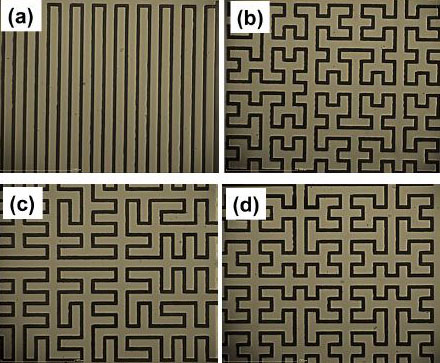| Posted: Nov 20, 2017 | |
Fabricating high-performance microsupercapacitors using fractal electrode designs |
|
| (Nanowerk Spotlight) The wearable power sources required for wearable and implantable electronic devices are limited by the size of the gadgets they power. Microsupercapacitors (MSCs) are newly emerging miniaturized high-power microelectrochemical energy-storage devices that are well-suited for this taks as they can deliver high power density, fast charge and discharge, and a superior cycling lifetime (millions of cycles). | |
| A new study published in Advanced Electronic Materials("Fractal Electrochemical Microsupercapacitors") shows that electrode fractal design is a viable strategy for improving the performance of integrated microsupercapacitors that use thin-film electrodes at no extra processing or fabrication cost. | |
| A team from King Abdullah University of Science and Technology (KAUST), led by professors Khaled N. Salama and Husam N. Alshareef has used sputtered anhydrous RuO2 thin-film electrodes as prototypes, and fabricated MSCs using three different Hilbert, Peano, and Moore fractal designs. | |
 |
|
| Photos of dies corresponding to a) IDE, b) FH, c) Peano, and d) FM electrode designs. (Image: Dr Mrinal Hota) | |
| "Fractal capacitors aren't just beautiful geometrical shapes, they have plenty of electronic advantages," Salama tells Nanowerk. "The fractal microsupercapacitors we fabricated show a 32% enhancement in energy density compared to conventional interdigital structures. The origin of this improvement can be attributed to the increased number of electrical lines of force in the fractal electrodes, which is caused by several open-edge segments." | |
| He notes that microsupercapacitor performance, including energy density, areal and volumetric capacitances, changes with fractal electrode geometry. | |
| Among the different electrode designs used in this study, the Moore design shows the best performance. Specifically, microsupercapacitors with the Fractal Moore electrode design exhibit a maximum areal capacitance of ∼11 mF cm-2 with a volumetric capacitance of ∼168 F cm-3 . | |
| In comparison, an areal capacitance of ∼8 mF cm-2 and a volumetric capacitance ∼125 F cm-3 were obtained in the case of IDE electrode design using identical electrode materials. | |
| The recent trend in supercapacitor or electrochemical capacitor research is to develop MSCs that are compatible with silicon-integrated circuits (ICs). Carbon-based materials have been widely used as an active electrode material for the development of MSCs devices. However, the integration of carbon-based materials in Si-based ICs is relatively challenging. To solve this technological bottleneck, Si IC-compatible materials that can be deposited using microfabrication compatible methods (e.g., sputtering, atomic layer deposition, evaporation) are preferred. | |
| "Our study shows that fractal electrode designs provide a promising approach to improving the performance of integrated electrochemical microsupercapacitors at no extra cost," Alshareef concludes. "Our next steps will be to explore other fractal shapes that may produce even better performance. In addition, we'll explore 3D fractal shapes." | |
 By
Michael
Berger
– Michael is author of three books by the Royal Society of Chemistry:
Nano-Society: Pushing the Boundaries of Technology,
Nanotechnology: The Future is Tiny, and
Nanoengineering: The Skills and Tools Making Technology Invisible
Copyright ©
Nanowerk LLC
By
Michael
Berger
– Michael is author of three books by the Royal Society of Chemistry:
Nano-Society: Pushing the Boundaries of Technology,
Nanotechnology: The Future is Tiny, and
Nanoengineering: The Skills and Tools Making Technology Invisible
Copyright ©
Nanowerk LLC
|
|
|
Become a Spotlight guest author! Join our large and growing group of guest contributors. Have you just published a scientific paper or have other exciting developments to share with the nanotechnology community? Here is how to publish on nanowerk.com. |
|
